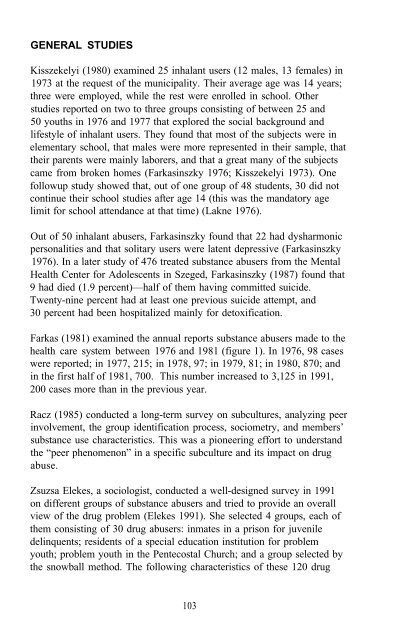Epidemiology of Inhalant Abuse - Archives - National Institute on ...
Epidemiology of Inhalant Abuse - Archives - National Institute on ...
Epidemiology of Inhalant Abuse - Archives - National Institute on ...
You also want an ePaper? Increase the reach of your titles
YUMPU automatically turns print PDFs into web optimized ePapers that Google loves.
GENERAL STUDIES<br />
Kisszekelyi (1980) examined 25 inhalant users (12 males, 13 females) in<br />
1973 at the request <str<strong>on</strong>g>of</str<strong>on</strong>g> the municipality. Their average age was 14 years;<br />
three were employed, while the rest were enrolled in school. Other<br />
studies reported <strong>on</strong> two to three groups c<strong>on</strong>sisting <str<strong>on</strong>g>of</str<strong>on</strong>g> between 25 and<br />
50 youths in 1976 and 1977 that explored the social background and<br />
lifestyle <str<strong>on</strong>g>of</str<strong>on</strong>g> inhalant users. They found that most <str<strong>on</strong>g>of</str<strong>on</strong>g> the subjects were in<br />
elementary school, that males were more represented in their sample, that<br />
their parents were mainly laborers, and that a great many <str<strong>on</strong>g>of</str<strong>on</strong>g> the subjects<br />
came from broken homes (Farkasinszky 1976; Kisszekelyi 1973). One<br />
followup study showed that, out <str<strong>on</strong>g>of</str<strong>on</strong>g> <strong>on</strong>e group <str<strong>on</strong>g>of</str<strong>on</strong>g> 48 students, 30 did not<br />
c<strong>on</strong>tinue their school studies after age 14 (this was the mandatory age<br />
limit for school attendance at that time) (Lakne 1976).<br />
Out <str<strong>on</strong>g>of</str<strong>on</strong>g> 50 inhalant abusers, Farkasinszky found that 22 had dysharm<strong>on</strong>ic<br />
pers<strong>on</strong>alities and that solitary users were latent depressive (Farkasinszky<br />
1976). In a later study <str<strong>on</strong>g>of</str<strong>on</strong>g> 476 treated substance abusers from the Mental<br />
Health Center for Adolescents in Szeged, Farkasinszky (1987) found that<br />
9 had died (1.9 percent)—half <str<strong>on</strong>g>of</str<strong>on</strong>g> them having committed suicide.<br />
Twenty-nine percent had at least <strong>on</strong>e previous suicide attempt, and<br />
30 percent had been hospitalized mainly for detoxificati<strong>on</strong>.<br />
Farkas (1981) examined the annual reports substance abusers made to the<br />
health care system between 1976 and 1981 (figure 1). In 1976, 98 cases<br />
were reported; in 1977, 215; in 1978, 97; in 1979, 81; in 1980, 870; and<br />
in the first half <str<strong>on</strong>g>of</str<strong>on</strong>g> 1981, 700. This number increased to 3,125 in 1991,<br />
200 cases more than in the previous year.<br />
Racz (1985) c<strong>on</strong>ducted a l<strong>on</strong>g-term survey <strong>on</strong> subcultures, analyzing peer<br />
involvement, the group identificati<strong>on</strong> process, sociometry, and members’<br />
substance use characteristics. This was a pi<strong>on</strong>eering effort to understand<br />
the “peer phenomen<strong>on</strong>” in a specific subculture and its impact <strong>on</strong> drug<br />
abuse.<br />
Zsuzsa Elekes, a sociologist, c<strong>on</strong>ducted a well-designed survey in 1991<br />
<strong>on</strong> different groups <str<strong>on</strong>g>of</str<strong>on</strong>g> substance abusers and tried to provide an overall<br />
view <str<strong>on</strong>g>of</str<strong>on</strong>g> the drug problem (Elekes 1991). She selected 4 groups, each <str<strong>on</strong>g>of</str<strong>on</strong>g><br />
them c<strong>on</strong>sisting <str<strong>on</strong>g>of</str<strong>on</strong>g> 30 drug abusers: inmates in a pris<strong>on</strong> for juvenile<br />
delinquents; residents <str<strong>on</strong>g>of</str<strong>on</strong>g> a special educati<strong>on</strong> instituti<strong>on</strong> for problem<br />
youth; problem youth in the Pentecostal Church; and a group selected by<br />
the snowball method. The following characteristics <str<strong>on</strong>g>of</str<strong>on</strong>g> these 120 drug<br />
103
















